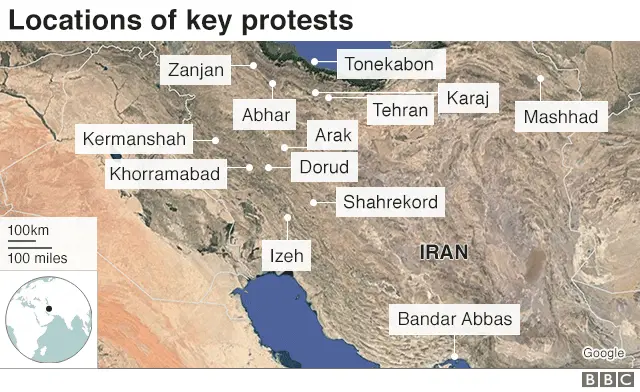Iran unrest: 'Ten dead' in further protests overnight
Ten people have been killed overnight in anti-government protests sweeping Iran, according to state TV.
"In the events of last night, unfortunately a total of about 10 people were killed in several cities," it said. At least 12 people have now died since protests began on Thursday.
On Monday, President Hassan Rouhani said the protests and criticism were an opportunity, not a threat.
He said the country should work together to fix its economic problems.
He said: "Our nation will deal with this minority who chant slogans against the law and people's wishes, and insult the sanctities and values of the revolution."
Mr Rouhani had previously said that citizens were free to protest, but not violently.
US President Donald Trump continued his war of words with Iran's leaders on Monday, posting a tweet saying the "great Iranian people have been repressed for many years. They are hungry for food and freedom".
Where has the violence happened?
Six of those killed died after shots were fired in the western town of Tuyserkan, 300km (185 miles) south-west of Tehran.
An official in the south-western town of Izeh said two people had died there. The other two people were reportedly killed in clashes in Dorud in Lorestan province.
Police also used tear gas and water cannon overnight to quell a rally in Tehran's Engheleb Square.
Demonstrations were also reported in Kermanshah and Khorramabad in the west, Shahinshahr in the north-west and in the northern city of Zanjan.
State TV said armed protesters had tried to take over some police stations and military bases, but faced serious resistance from security forces.
The demonstrations, which erupted on Thursday in Iran's second city of Mashhad, are the biggest show of dissent seen since the huge rallies of the Green Movement were brutally suppressed in 2009.
Judiciary Chief Ayatollah Sadeq Amoli-Larijani called for a crackdown on "rioters" and "vandals" on Monday, according to state television.
"Some individuals are exploiting the situation. This is wrong," he said.

How have authorities responded to protests?
Mr Rouhani has acknowledged popular grievances, though he warned that the government would show "no tolerance for those who damage public properties, violate public order and create unrest in the society".
On Monday he said on Twitter that the government needed to pay attention to people's demands on livelihood issues and corruption.
Iran's Revolutionary Guards Corps (IRGC) warned anti-government protesters would face the nation's "iron fist" if political unrest continued.
The IRGC is a powerful force with ties to the country's supreme leader, and is dedicated to preserving the country's Islamic system. Correspondents say it would be a significant escalation were they to become officially involved in policing the protests.
Up to 400 people are reported to have been arrested in recent days, including 200 in Tehran on Saturday night.
And authorities continue to sporadically suspend social media websites they fear will be used to organise protests, including Telegram and Instagram.
State media have now begun broadcasting some footage on the protests, though focuses on young men attacking banks and vehicles or burning the Iranian flag, reported AFP news agency.
On Sunday police used water cannon to disperse protesters at a major intersection, as captured in a video obtained by BBC Persian.
Allow Twitter content?
Where will the protests lead?
Analysis by Kasra Naji, BBC Persian
There is widespread and seething discontent in Iran where repression is pervasive and economic hardship is getting worse - one BBC Persian investigation has found that on average Iranians have become 15% poorer in the past 10 years.
Protests have remained confined to relatively small pockets of mostly young male demonstrators who are demanding the overthrow of the clerical regime.
They have spread to small towns throughout the country and have the potential to grow in size.
But there is no obvious leadership. Opposition figures have long been silenced or sent into exile.
Some protesters have been calling for the return of the monarchy and the former shah's son, Reza Pahlavi, who lives in exile in the United States, has issued a statement supporting the demonstrations. But there are signs that he is as much in the dark about where these protests are going as anyone else.
BBC Persian, which broadcasts on TV, on radio and online from London, is banned in Iran - where staff and their families routinely face harassment and questioning from the authorities.
What about Rouhani's war of words with Trump?
Mr Rouhani described the US president as an "enemy of the Iranian nation from the top of his head to his very toes".
He said the "man who today in America wants to sympathise with our people has forgotten that a few months ago he called the nation of Iran terrorist".
Mr Trump has sent various tweets criticising Iran's leaders since the protests began.
He said Iranians were "finally getting wise as to how their money and wealth is being stolen and squandered on terrorism".
His tweet on Monday said in capital letters "TIME FOR CHANGE!"
Allow Twitter content?
What happened in 2009?
Mass demonstrations - referred to as the Green Movement - were held by millions of opposition supporters against the disputed election victory of incumbent president Mahmoud Ahmadinejad.
At least 30 people were killed and thousands arrested in the wave of protests, which drew the largest crowds in Iran since the Islamic Revolution in 1979.

